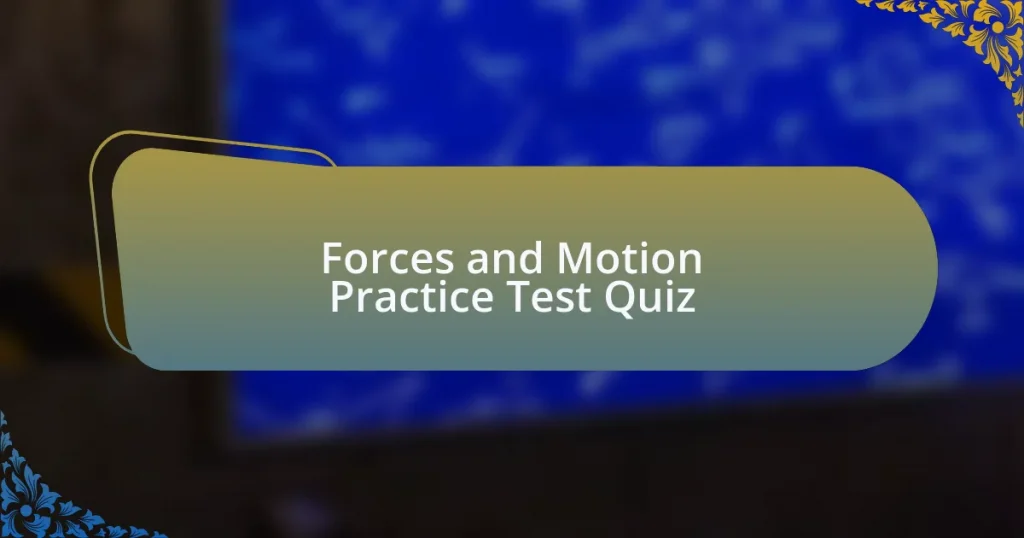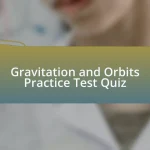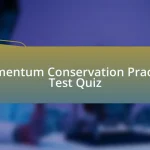Start of Forces and Motion Practice Test Quiz
1. What is the definition of force?
- A force is the mass of an object.
- A force is a push or a pull.
- A force is a type of energy.
- A force is the speed of an object.
2. Which of the following is an example of acceleration?
- A train moving at a constant speed.
- A rock resting on the ground.
- A car reversing slowly.
- A boat speeding up.
3. If one person pulls a heavy couch to the left and another person pushes it in the same direction, then?
- The net force will be greater than the force exerted by one person.
- The net force will cancel out to zero.
- The couch will move to the right.
- The couch will not move at all.
4. A car traveling at 80 km/h north is an example of?
- Displacement
- Acceleration
- Velocity
- Speed
5. Friction will _________________ the amount of movement between two objects.
- Maintain
- Randomize
- Decrease
- Increase
6. The graph at right shows an object?
- Accelerating to the left.
- Moving away from you.
- Moving towards you.
- Stationary at rest.
7. The support force of a table holding up a book is called ____________.
- Gravity force
- Support force
- Normal force
- Frictional force
8. A force is a ________________ or a ________________. The unit used to measure force are ____________.
- A twist or a turn, Pascals.
- A push or a pull, Newtons.
- A lift or a drop, Joules.
- A shove or a shove, Watts.
9. Air resistance is a type of _________________. How is air resistance helpful?
- Magnetic force. It helps in creating heat.
- Drag force. It helps in slowing down objects.
- Electrical force. It helps in launching objects.
- Gravitational force. It helps in speeding up objects.
10. An object’s motion will change if the forces acting on it are _______________________________.
- Equal.
- Opposite.
- Unbalanced.
- Static.
11. A lion runs 400 meters in 20 seconds. What is the lion’s average speed?
- 15 m/s.
- 5 m/s.
- 20 m/s.
- 10 m/s.
12. A helicopter is traveling at a velocity of 500 km/h over Seattle headed south. It flies over Portland 2 hours later at a velocity of 400 km/h south. What is the helicopter’s acceleration?
- Zero acceleration.
- -100 km/h².
- 50 km/h².
- 100 km/h².
13. James Bond is running inside a train. The train is traveling 30 m/s east. Bond is running 3 m/s west. What is James Bond’s overall velocity?
- 27 m/s east.
- 33 m/s east.
- 27 m/s west.
- 33 m/s west.
14. A monkey is sitting in a tree when suddenly he gets dizzy and falls. Right before landing on his feet 5 seconds later, his velocity is 49 m/s. What is his acceleration?
- 0 m/s².
- 49 m/s².
- 9.8 m/s².
- -9.8 m/s².
15. Use an example to show why a reference point is necessary to detect motion.
- Example: A car moving in a parking lot relies on the driver to feel its motion.
- Example: A bird flying in the sky uses trees to determine if it`s moving.
- Example: A train stops at a station without needing any reference point to measure its motion.
- Example: A car moving on a straight road needs a reference point like the road to detect its motion.
16. Give a specific example of a force that starts an object moving.
- Sunlight
- Push from a person
- Wind
- Water
17. Which one(s) of the following free body diagrams depict an object accelerating to the right?
- Diagrams with forces pointing to the left.
- Diagrams showing net force to the right.
- Diagrams with no net force indicated.
- Diagrams showing equal forces in opposite directions.
18. In the diagram above, which of the objects would be at rest? What must be true about the forces if an object is at rest?
- Objects moving at a constant speed.
- Objects experiencing only gravitational force.
- Objects with a force greater than the weight.
- Objects with zero net force.
19. In the diagram above, which of the objects would be accelerating the fastest?
- Objects with equal forces acting on them.
- Objects with the greatest net force.
- Objects moving at constant speed.
- Objects with the lowest mass.
20. Each diagram below shows the forces acting on an object and states the net force (Fnet). What must the forces be in order to create the net force listed?
- Specific forces listed in each diagram.
- Forces that cancel each other out.
- Random forces without relation to the net force.
- Forces too weak to achieve the net force.
21. A circus monkey is about to be shot from a cannon as part of his thrilling circus act. Draw a free body diagram showing all forces acting on the monkey.
- Diagram showing gravity and surface tension forces.
- Diagram showing tension and air resistance forces only.
- Diagram showing forces like tension, gravity, and normal force.
- Diagram showing only friction and gravity forces.
22. What is the acceleration of a 20kg object moved by a resultant force of 500N?
- 25 m/s².
- 15 m/s².
- 20 m/s².
- 10 m/s².
23. If a car is traveling at 60 km/h and then accelerates to 90 km/h in 10 seconds, what is its acceleration?
- 4 m/s²
- 5 m/s²
- 6 m/s²
- 3 m/s²
24. A ball is thrown upwards with an initial velocity of 20 m/s. What is its velocity after 2 seconds?
- 0 m/s
- 20 m/s
- 5 m/s
- -20 m/s
25. A bicycle is moving at a constant speed of 10 m/s. What is its acceleration?
- 10 m/s².
- 5 m/s².
- Zero acceleration.
- 15 m/s².
26. A car is traveling at a constant speed of 50 km/h. What is its acceleration?
- Zero acceleration.
- 100 km/h.
- 25 m/s².
- 50 m/s².
27. A force of 100N is applied to an object for 5 seconds. What is the impulse of the force?
- 200 Ns.
- 500 Ns.
- 1000 Ns.
- 300 Ns.
28. A 10kg object is moving at a velocity of 5 m/s. What is its momentum?
- 200 kg m/s
- 50 kg m/s
- 100 kg m/s
- 20 kg m/s
29. A force of 200N is applied to an object for 10 seconds. What is the impulse of the force?
- 20000 Ns.
- 20 Ns.
- 200 Ns.
- 2000 Ns.
30. A 20kg object is moving at a velocity of 10 m/s. What is its kinetic energy?
- 50 J.
- 400 J.
- 1000 J.
- 200 J.
Congratulations! You’ve Completed the Forces and Motion Practice Test
Well done on completing the quiz on Forces and Motion! Your participation demonstrates not only your interest in physics but also your commitment to mastering these essential concepts. Throughout the quiz, you examined various aspects of forces, such as Newton’s laws, friction, and acceleration. This knowledge is fundamental to understanding how objects move and interact in our world.
As you progressed through the questions, you may have discovered new insights about the relationship between force and motion. Perhaps you now have a clearer understanding of how mass affects acceleration or the role of gravity in everyday life. Each question was designed to enhance your grasp of these principles, making you more confident in applying them to real-world scenarios.
If you found value in this quiz, we invite you to explore the next section on this page. There, you’ll find additional resources that delve deeper into Forces and Motion. Expanding your knowledge in this area will provide you with a well-rounded foundation for your physics studies. Keep pushing your limits and enjoy the journey of learning!
Forces and Motion Practice Test
Understanding Forces and Motion in Physics
Forces and motion are fundamental concepts in physics that describe how objects interact and move. Forces are pushes or pulls acting on objects, causing them to change velocity or direction. Motion refers to the change in position of an object over time. Newton’s Laws of Motion, which include the concepts of inertia and acceleration, illustrate the relationship between forces and motion. Understanding these principles is critical for solving problems in mechanics and other physics-related topics.
Types of Forces Affecting Motion
Forces can be categorized into contact and non-contact forces. Contact forces include friction, tension, and normal force, which arise from physical interactions. Non-contact forces, such as gravitational and electromagnetic forces, act at a distance. Each type of force influences the motion of objects differently. For instance, friction opposes motion, while gravitational force pulls objects toward one another, affecting their trajectories. Mastery of these types enhances problem-solving abilities in physics theorems.
Key Equations for Forces and Motion
Key equations govern the relationships between forces, mass, and acceleration. Newton’s second law, stated as F=ma, defines the force (F) acting on an object as the product of its mass (m) and acceleration (a). Other essential equations include those for calculating work, energy, and momentum. These equations serve as the foundation for understanding how forces apply to real-world situations, aiding in accurate predictions of motion.
Common Problems and Solutions in Forces and Motion
Typical problems in forces and motion include calculating net force, determining acceleration, and analyzing motion on inclined planes. These problems often require the application of Newton’s laws and relevant equations. For example, to find net force, one must sum all acting forces, considering both direction and magnitude. Solution strategies involve diagramming forces and systematically applying mathematical principles, fostering deeper comprehension of motion dynamics.
Preparation Strategies for Forces and Motion Tests
Effective preparation for forces and motion tests involves reviewing key concepts, practicing problem-solving, and utilizing practice tests. Students should focus on understanding definitions, mastering key equations, and identifying common problem types. Engaging in practice tests further reinforces knowledge and identifies areas requiring more focus. Time management during test preparations can significantly enhance performance and confidence going into actual assessments.
What is a Forces and Motion Practice Test?
A Forces and Motion Practice Test is an assessment tool designed to evaluate a student’s understanding of the fundamental concepts of forces and motion in physics. It typically includes questions on Newton’s laws of motion, types of forces (like gravity and friction), and the relationships between mass, acceleration, and force. Such tests often feature multiple-choice or short-answer questions that require students to apply their knowledge to solve physics problems.
How can you prepare for a Forces and Motion Practice Test?
To prepare for a Forces and Motion Practice Test, students should review key concepts and definitions in mechanics, especially Newton’s laws, free body diagrams, and equations of motion. They can practice with sample problems and previous tests to identify weak areas. Additionally, engaging in group study sessions and utilizing online resources can enhance understanding. Consistent practice and the application of concepts to real-world scenarios are crucial for successful preparation.
Where can you find resources for a Forces and Motion Practice Test?
Resources for a Forces and Motion Practice Test can be found in various educational platforms, including school textbooks, online educational websites, and physics learning apps. Websites such as Khan Academy and Quizlet offer practice problems and quizzes. Teachers often provide study guides and additional worksheets to assist students in their preparation.
When is a Forces and Motion Practice Test typically administered?
A Forces and Motion Practice Test is usually administered after a unit covering the topic is completed, often within a high school physics course. This can occur at the end of the lesson plan or during a review week prior to a final examination. The timing may vary based on the curriculum and the instructor’s pacing.
Who benefits from taking a Forces and Motion Practice Test?
High school and college students studying physics benefit from taking a Forces and Motion Practice Test. It helps them reinforce their learning, assess their grasp of vital concepts, and identify areas needing improvement. Educators also benefit, as these tests provide insights into student understanding and can guide their teaching strategies effectively.















